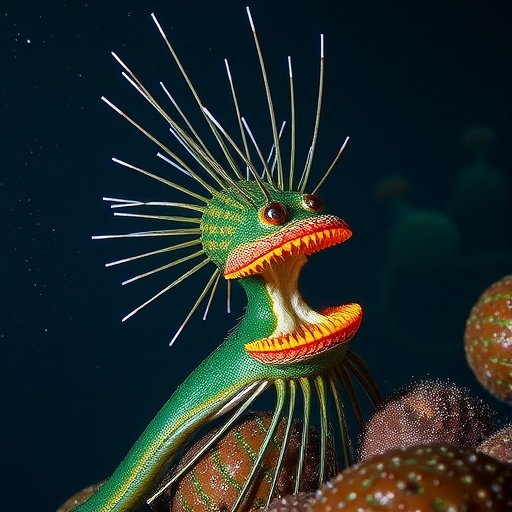In the vast, shadowy expanses of the ocean’s midwater zones, a previously hidden ecosystem is now emerging as a focal point for scientific inquiry and environmental concern. Recent research published in Nature Communications highlights the profound impact that deep-sea mining discharge has on these midwater food webs, uncovering disruptions with potentially cascading effects on marine biodiversity and ecosystem health. This groundbreaking study, authored by Dowd, Assad, Cazares-Nuesser, and colleagues, presents a detailed examination of how sediment plumes generated by mining activities infiltrate midwater habitats, altering the delicate balance of life far from the seabed.
Deep-sea mining, a rapidly advancing industry aimed at extracting precious metals and minerals from the ocean floor, produces massive quantities of waste material that are discharged back into the water column. Unlike terrestrial mining byproducts, these sediments and associated chemical contaminants enter an environment characterized by darkness, high pressure, and scant resources, where marine organisms have evolved highly specialized adaptations. The research reveals that the slurry-like plumes rise and spread horizontally, intruding into the midwater depths, an ecological zone pivotal for nutrient cycling and trophic transfer.
The midwater layer, often referred to as the mesopelagic zone, extends from approximately 200 to 1,000 meters below the ocean’s surface. It hosts a myriad of planktonic organisms, small fishes, and cephalopods that form the foundation of the midwater food web. Crucially, this zone acts as a conduit for energy and matter, connecting surface productivity with deeper benthic communities and apex predators. Findings from the study indicate that the sediment discharge interferes with feeding behaviors, sensory perception, and reproductive cycles of midwater species, highlighting a mechanism by which mining-induced pollution can ripple through oceanic ecosystems.
Methodologically, the researchers employed cutting-edge submersible technology and in situ sampling techniques to map sediment dispersion and its biological impacts. High-resolution imaging and molecular analyses were used to assess species abundance, diversity, and physiological stress markers. These data unveiled striking shifts in community composition following experimental exposure to mining discharge, with several key species experiencing population declines. Notably, filter-feeding zooplankton taxa, essential for carbon transport via the biological pump, exhibited impaired feeding efficiency, suggesting a disruption in global biogeochemical cycles.
This discovery has significant implications for global ocean health and the sustainability of deep-sea resource extraction. The mesopelagic zone’s role in carbon sequestration—transferring atmospheric CO2 into the deep ocean—is jeopardized by sediment-induced disturbances. The researchers stress the interconnectedness of these processes, underscoring how localized mining impacts could exacerbate climate change effects through feedback mechanisms. Moreover, commercially important species inhabiting these waters may face population declines, with potential socioeconomic consequences for fisheries and coastal communities.
Environmental managers and policymakers now face a critical juncture. As international bodies and corporations race to unlock the mineral wealth embedded in seabed nodules and sulfide deposits, the ecological collateral damage remains insufficiently understood. This comprehensive study advocates for the integration of midwater ecological considerations into environmental impact assessments and regulatory frameworks. The authors argue for stringent monitoring protocols and the development of technologies to mitigate sediment plume dispersal, fostering sustainable extraction practices that balance economic and environmental priorities.
The findings also call attention to the importance of protecting midwater habitats as distinct ecological entities. Traditionally, conservation efforts have prioritized coastal and benthic zones, but this work demonstrates that the midwater column harbors biodiversity deserving of dedicated stewardship. Conservation strategies incorporating the full vertical range of marine environments will be necessary to maintain ecosystem resilience under increasing anthropogenic pressures.
Furthermore, the research opens avenues for future scientific exploration into the physiological responses of midwater organisms to anthropogenic stressors. Understanding how sediment exposure affects metabolic rates, behavioral patterns, and interspecies interactions will deepen insights into ecosystem destabilization pathways. Such data are vital for predictive models that anticipate the long-term consequences of deep-sea mining on marine food webs.
The study’s multidisciplinary approach, combining oceanography, marine biology, and environmental science, exemplifies the complexity of addressing human impacts on ocean ecosystems. Collaboration across scientific disciplines and industry stakeholders will be essential in crafting evidence-based policies and advancing sustainable ocean resource management. As this research underscores, the deep sea is not a distant frontier immune to human influence but a vulnerable habitat requiring urgent attention.
Technological advancements also emerge as a critical component in mitigating environmental risks. Innovations in sediment containment, real-time monitoring sensors, and remote-operated vehicles equipped with environmental diagnostic tools hold promise for reducing mining footprints. The researchers highlight the urgent need for investment in such technologies to align industrial activity with ecological preservation goals.
Ultimately, this work serves as a clarion call to the global scientific and policy community. Protecting midwater ecosystems from the unintended consequences of deep-sea mining is not only a matter of conserving marine biodiversity but also of safeguarding ocean functions vital to climate regulation and food security. Continued research, transparent data sharing, and proactive governance frameworks are imperative to mitigate these emerging threats.
The revelations provided by Dowd and colleagues profoundly illustrate the intricate web of life beneath ocean surfaces and the fragility of its balance. As humanity ventures further into deep-sea exploitation, this study stands as a testament to the necessity of comprehensive environmental stewardship rooted in scientific rigor. The ocean’s midwater realm, once shrouded in mystery, now demands attention as an essential theater for sustaining planetary health.
In conclusion, this pioneering research illuminates an often-overlooked dimension of mining pollution, challenging assumptions about how human activities impact marine ecosystems beyond the seabed. It calls for an urgent reevaluation of environmental safeguards to encompass the dynamic, three-dimensional nature of ocean habitats. By revealing the hidden costs of deep-sea mining discharge, it charts a course toward more responsible interaction with the marine environment, preserving its complexity for generations to come.
Subject of Research: Deep-sea mining impacts on midwater food webs and ecology
Article Title: Deep-sea mining discharge can disrupt midwater food webs
Article References:
Dowd, M.H., Assad, V.E., Cazares-Nuesser, A.E. et al. Deep-sea mining discharge can disrupt midwater food webs. Nat Commun 16, 9575 (2025). https://doi.org/10.1038/s41467-025-65411-w
Image Credits: AI Generated




